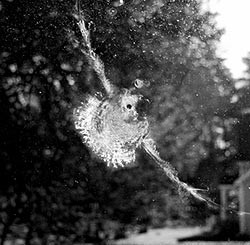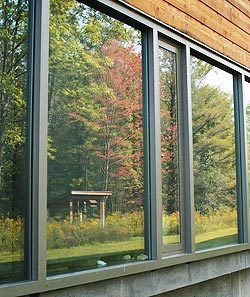It’s a startling and often upsetting experience: the sudden thud of a bird hitting your window. You might find yourself repeatedly asking, “Why Does This Bird Keep Flying Into My Window?” This isn’t just a random occurrence; it’s a widespread issue that poses a significant threat to bird populations. Understanding the reasons behind these collisions and taking action to prevent them is crucial for bird conservation.
Photo by Susan Spear/Cornell Lab.
For birds, the clear, reflective surfaces of our windows are deceptively dangerous. Instead of perceiving a solid barrier, birds often see inviting reflections of the surrounding environment – trees, sky, and vegetation. This illusion turns windows into invisible obstacles in their flight path. The sheer number of windows in our homes and buildings makes this a massive problem. Studies estimate that in the United States alone, window strikes cause up to one billion bird deaths annually. This staggering figure, highlighted in a 2014 study published in The Condor: Ornithological Applications, underscores the urgent need for solutions.
Fortunately, there are effective and straightforward ways to significantly reduce the danger your windows pose to birds. Experts like Christine Sheppard, who leads the Bird Collisions Program at the American Bird Conservancy (ABC), emphasize that simple remedies can make a big difference. The ABC and organizations like the Fatal Light Awareness Program (FLAP) provide extensive resources and guidance on preventing bird collisions, offering practical steps that homeowners and building managers can implement.
What exactly happens when a bird hits a window? The impact is often fatal, even if the bird appears to fly away initially. While a bird might seem merely stunned after a collision, it can suffer from severe internal injuries, including brain hemorrhaging and bruising, that lead to death later. Daniel Klem, a researcher at Muhlenberg College who has studied bird window collisions for decades, poignantly describes glass as “an indiscriminate killer,” affecting healthy birds as much as weaker individuals. This highlights that window collisions are not just removing the sick or weak from bird populations, but are a significant factor in overall bird mortality.
The Reasons Behind Bird Window Collisions
 imprint of dove on plate glass window
imprint of dove on plate glass window
Bird window collisions can be broadly categorized into daytime and nighttime incidents, each with distinct causes.
Daytime Collisions: The Illusion of Open Space
During the day, birds primarily collide with windows because they perceive reflections as real environments. Windows mirroring trees, bushes, gardens, or the sky create the illusion of a continuous habitat. Birds, attempting to fly towards these seemingly open spaces or through perceived passageways, crash into the glass. Similarly, seeing through windows to indoor plants or vegetation on the other side can also lure birds into a collision. They don’t recognize the transparent barrier and are tragically misled by what appears to be a safe route.
Nighttime Collisions: Drawn to the Light
At night, the primary culprits are artificial lights. Nocturnal migrating birds, which include the majority of songbird species, are particularly vulnerable. Lights from buildings and urban areas disorient these birds during their migrations. The reasons for this disorientation are not fully understood, but it’s believed that lights, especially in foggy or low-ceiling conditions, can deviate birds from their natural migratory paths.
Drawn to brightly lit areas, these migrants can become trapped, circling within the illuminated zone and colliding with lighted structures, including windows. Even if they avoid immediate collision, the artificial light can disrupt their migration, causing them to expend crucial energy and delaying their journey. Furthermore, birds attracted to urban lights may find temporary roosting spots but then face the hazards of daytime window reflections the following day, creating a double threat. Projects like BirdCast and the Fatal Light Awareness Program (FLAP) offer extensive information and resources on the dangers of light pollution to birds.
Territorial Aggression: Attacking Reflections
There’s another, less deadly, reason why a bird might repeatedly fly into your window: territoriality. Especially during spring breeding season, birds may see their own reflection in a window and mistake it for a rival. This triggers aggressive behavior as they attempt to defend their territory and drive away the perceived intruder. While this behavior can be persistent and annoying to homeowners, it rarely results in serious injury to the bird. Fortunately, many of the solutions designed to prevent window strikes are also effective in stopping birds from attacking their reflections.
How to Make Your Windows Bird-Safe
 reflection of foliage in window – hazard to birds
reflection of foliage in window – hazard to birds
The first step in safeguarding birds from your windows is to identify the most dangerous ones. Large picture windows, corner windows that create see-through effects, and windows near bird feeders are particularly hazardous. To assess the danger, go outside and look at your windows from a bird’s perspective. If you see reflections of vegetation or sky, or can see through to the other side, birds are likely seeing the same illusions.
Contrary to older advice, the distance of bird feeders from windows is not the primary factor. If you have windows near feeders, focusing on making the windows bird-friendly is more important than feeder placement.
Here are practical treatments for existing windows and considerations for new homes to minimize bird collisions:
Solutions for Existing Windows
For smaller birds, markings should be spaced no more than 2 inches apart uniformly across the window’s exterior surface. This spacing is critical to deter even the smallest birds like hummingbirds and kinglets. Acopian BirdSavers, using paracord, can be spaced up to 4 inches apart due to their higher visibility. Crucially, all treatments must be applied to the outside of the window.
-
Tempera Paint or Soap: A simple and cost-effective method is to use tempera paint or soap to create patterns on the exterior of your windows. A 2×2 inch grid pattern is effective, or you can create more decorative designs. These are easily applied and long-lasting, yet removable.
-
Decals, Stickers, and Tape: Applying decals, stickers, sun catchers, mylar strips, or even masking tape to the outside of your windows can break up reflections. However, effectiveness depends on close spacing. Hawk silhouettes alone are largely ineffective. Remember, a few stickers on a large window are insufficient; most of the glass surface needs to be covered with narrow gaps in between.
-
Dot Patterns and Tape Products: Specialized tape products with pre-spaced dot patterns offer an easy way to achieve the correct spacing. Products from companies like Feather Friendly are designed specifically for bird collision prevention and are highly effective.
-
Acopian BirdSavers (Zen Curtains): These consist of closely spaced cords hanging vertically down the window. They provide a visual barrier that deters birds and are easier to install than tape or decals. They are aesthetically pleasing and highly effective, used even at the Cornell Lab of Ornithology headquarters. You can purchase pre-made BirdSavers or create your own.
-
Screens: Mosquito screens, when installed on the exterior and covering the entire window surface, are very effective. They provide a physical barrier that birds recognize.
-
Netting: Covering windows with netting on the outside, positioned at least 3 inches away from the glass and taut enough to deflect birds, is another robust solution. Small-mesh netting (around 5/8″ or 1.6 cm) is ideal to prevent entanglement while ensuring birds bounce off safely. Netting can be mounted on frames for easy installation and removal.
-
One-Way Transparent Film: Films like Collidescape are applied to the exterior and allow people inside to see out while making the window appear opaque to birds from the outside. These films can also reduce light transmission, potentially lowering cooling costs.
Considerations for New Homes and Remodeling
When building a new home or replacing windows, consider these preventative measures:
-
External Shutters: Install external shutters and close them when rooms are unoccupied or when natural light and views are not needed. Shutters also offer significant energy savings.
-
External Sun Shades and Awnings: Install awnings or sun shades to block sunlight reflection on windows. Remote-controlled options provide convenience.
-
Windows with External Screens: Opt for windows designed with screens covering the entire exterior glass surface.
-
Interior Vertical Blinds: Using interior vertical blinds and keeping slats partially closed can help reduce reflections.
-
Minimize Visual Paths to Sky and Greenery: Avoid creating direct visual paths through your house to outdoor greenery or sky. For example, windows directly opposite each other can create the illusion of an open corridor. Closing interior doors or using window coverings can break these visual pathways.
Lights Out Initiatives
“Lights Out” programs are gaining momentum in many cities across the U.S., including major migratory routes. Reducing nighttime lighting in urban environments, particularly in tall buildings, is crucial for protecting migrating birds. Turning off non-essential lights and using downward-facing lighting significantly reduces light pollution’s impact. Even with community-wide efforts, individual homeowners should still implement window safety measures, especially during migration seasons.
Helping a Bird That Has Hit a Window
Despite preventative measures, collisions can still occur. If you find a bird that has hit your window, immediate action can improve its chances of survival. Window collision victims often suffer internal injuries not immediately apparent and are vulnerable to predators if left unattended.
Here’s how to help a bird that has struck a window:
-
Capture and Contain: Approach the bird gently from behind and use both hands to carefully scoop it up. Small birds are fragile, so hold them gently but securely, preventing them from fluttering and potentially causing further injury.
-
Prepare a Container: Find a safe container, such as an unwaxed paper bag or a small cardboard box lined with soft tissue or paper towel for grip. Place the bird in the container and close it securely.
-
Provide a Safe Environment: Keep the contained bird in a dark, quiet, warm, and safe place, away from children and pets.
-
Do Not Offer Food or Water: Avoid handling, feeding, or watering the bird. Wild birds perceive humans as threats, and unnecessary interaction can cause further stress.
-
Contact a Wildlife Rehabilitator: Locate a licensed wildlife rehabilitator in your area (using online directories like the Humane Society’s) and contact them for guidance. They can provide specific instructions and care or arrange for the bird to be transported to their facility.
-
Release (If Instructed): If the rehabilitator advises you to release the bird, take it to a safe, wooded area away from buildings and human activity. Before releasing, observe the bird’s flight ability. Point the opening of the bag or box towards vegetation and gently open it. If the bird doesn’t fly strongly, recapture it and contact the rehabilitator again for further instructions.
By understanding why birds fly into windows and implementing these preventative and responsive measures, you can make a significant positive impact on bird conservation and reduce the tragic toll of window collisions. Making your home and community safer for birds is a rewarding step in protecting these vital and beautiful creatures.